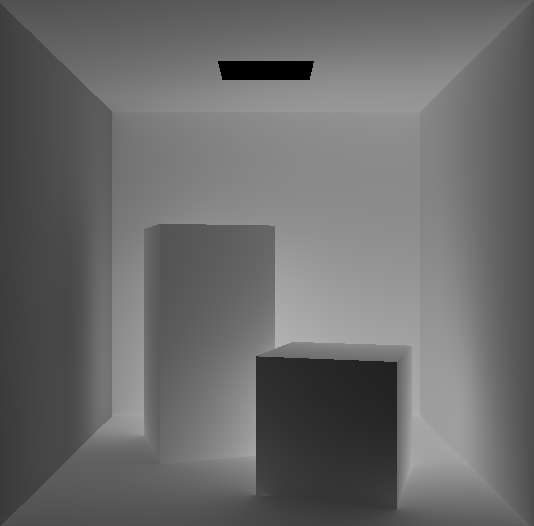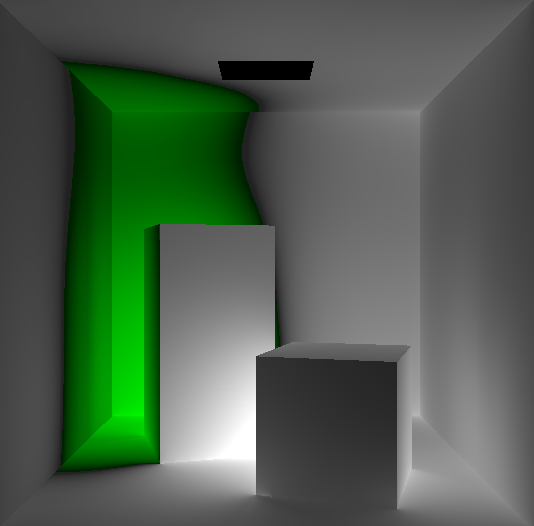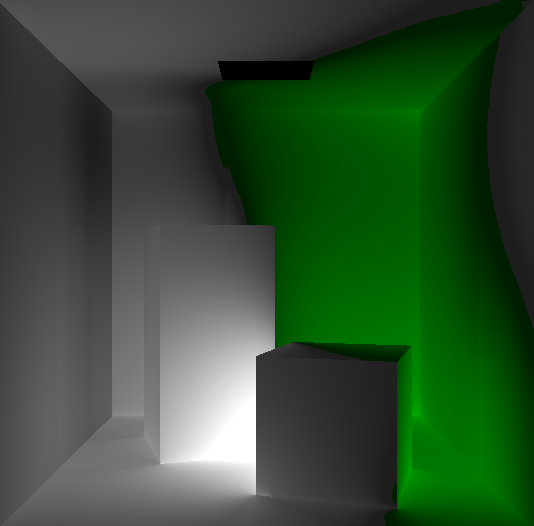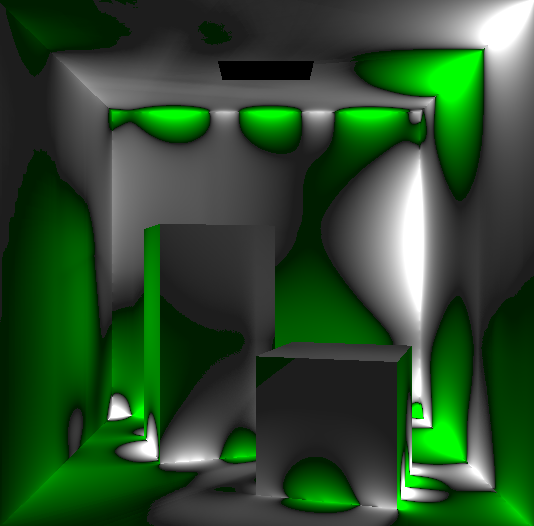Section: New Results
Illumination simulation and materials
Harmonic Analysis of the Light Transport Operator
Participants : Ronak Molazem, Cyril Soler.
In this work we study the eigenvalues and eigenfunctions of the light transport operator. While computing the spectrum of the light transport operator is a simple task in Lambertian scenes by applying a traditional eigensolver to the linear system obtained from discretized geometry, it becomes a real challenge in general environments where discretizing the geometry is not possible anymore. “Diagonalizing” light transport however can be a very effective way to perform re-lighting and rapidely compute light transport solutions.
In this work we propose an analysis of the properties of the spectrum of the light transport operator, connecting the calculation of eigenvalues to resolvent theory. We show that the eigenfunctions are generally not orthogonal nor positive, but they can still be used to efficiently represent light distributions.
We analyse the performance of different methods to compute eigenvalues and images of their eigenfunctions using path tracing. We prove in particular that it is possible to compute the eigenfunctions of the light transport operator by integrating "circular" light paths of various lengths accross the scene.
This work is part of the PhD of Ronak Molazem and is funded by the ANR project "CaLiTrOp". At the time of writing this (Dec. 2019), we're about to submit a paper to ACM Transactions on Graphics.
|
Low Dimension Approximations of Light Transport
Participants : Ronak Molazem, Cyril Soler.
Light transport is known to be a low rank linear operator: the vector space formed by solutions of a light transport problem for different initial conditions is of low dimension. Approximating this space using appropriate bases is therefore of primordial help to efficiently compute solutions to light transport problems.
In this work, we're interested into generating such approximations using ad-hoc methods that rely on deep learning. The goal is to be able to efficiently generate a sensible basis for light transport solutions on which we can efficiently project a noisy image. Other applications of this work include relighting pictures, in which an approximate geometry is used to project the illumination in the image, that can further be manipulated while staying in the space of expected light transport solutions.
This work is an ongoing collaboration with Unity Research Grenoble, and part of the PhD of Ronak Molazem, currently in her second year of PhD, and is funded by the ANR project "CaLiTrOp".
Precomputed Multiple Scattering for Rapid Light Simulation in Participating Media
Participants : Nicolas Holzschuch, Liangsheng Ge, Beibei Wang.
Rendering translucent materials is costly: light transport algorithms need to simulate a large number of scattering events inside the material before reaching convergence. The cost is especially high for materials with a large albedo or a small mean-free-path, where higher-order scattering effects dominate. In [7], we present a new method for fast computation of global illumination with participating media. Our method uses precomputed multiple scattering effects, stored in two compact tables. These precomputed multiple scattering tables are easy to integrate with any illumination simulation algorithm. We give examples for virtual ray lights (VRL), photon mapping with beams and paths (UPBP), Metropolis Light Transport with Manifold Exploration (MEMLT). The original algorithms are in charge of low-order scattering, combined with multiple scattering computed using our table. Our results show significant improvements in convergence speed and memory costs, with negligible impact on accuracy.
Fast Computation of Single Scattering in Participating Media with Refractive Boundaries using Frequency Analysis
Participants : Nicolas Holzschuch, Yulin Liang, Lu Wang, Beibei Wang.
Many materials combine a refractive boundary and a participating media on the interior. If the material has a low opacity, single scattering effects dominate in its appearance. Refraction at the boundary concentrates the incoming light, resulting in an important phenomenon called volume caustics. This phenomenon is hard to simulate. Previous methods used point-based light transport, but attributed point samples inefficiently, resulting in long computation time. In [3], we use frequency analysis of light transport to allocate point samples efficiently. Our method works in two steps: in the first step, we compute volume samples along with their covariance matrices, encoding the illumination frequency content in a compact way. In the rendering step, we use the covariance matrices to compute the kernel size for each volume sample: small kernel for high-frequency single scattering, large kernel for lower frequencies. Our algorithm computes volume caustics with fewer volume samples, with no loss of quality. Our method is both faster and uses less memory than the original method. It is roughly twice as fast and uses one fifth of the memory. The extra cost of computing covariance matrices for frequency information is negligible.
Reparameterizing discontinuous integrands for differentiable rendering
Participants : Nicolas Holzschuch, Wenzel Jakob, Guillaume Loubet.
Differentiable rendering has recently opened the door to a number of challenging inverse problems involving photorealistic images, such as computational material design and scattering-aware reconstruction of geometry and materials from photographs. Differentiable rendering algorithms strive to estimate partial derivatives of pixels in a rendered image with respect to scene parameters, which is difficult because visibility changes are inherently non-differentiable.
We propose [5] a new technique for differentiating path-traced images with respect to scene parameters that affect visibility, including the position of cameras, light sources, and vertices in triangle meshes. Our algorithm computes the gradients of illumination integrals by applying changes of variables that remove or strongly reduce the dependence of the position of discontinuities on differentiable scene parameters. The underlying parameterization is created on the fly for each integral and enables accurate gradient estimates using standard Monte Carlo sampling in conjunction with automatic differentiation. Importantly, our approach does not rely on sampling silhouette edges, which has been a bottleneck in previous work and tends to produce high-variance gradients when important edges are found with insufficient probability in scenes with complex visibility and high-resolution geometry. We show that our method only requires a few samples to produce gradients with low bias and variance for challenging cases such as glossy reflections and shadows. Finally, we use our differentiable path tracer to reconstruct the 3D geometry and materials of several real-world objects from a set of reference photographs.






